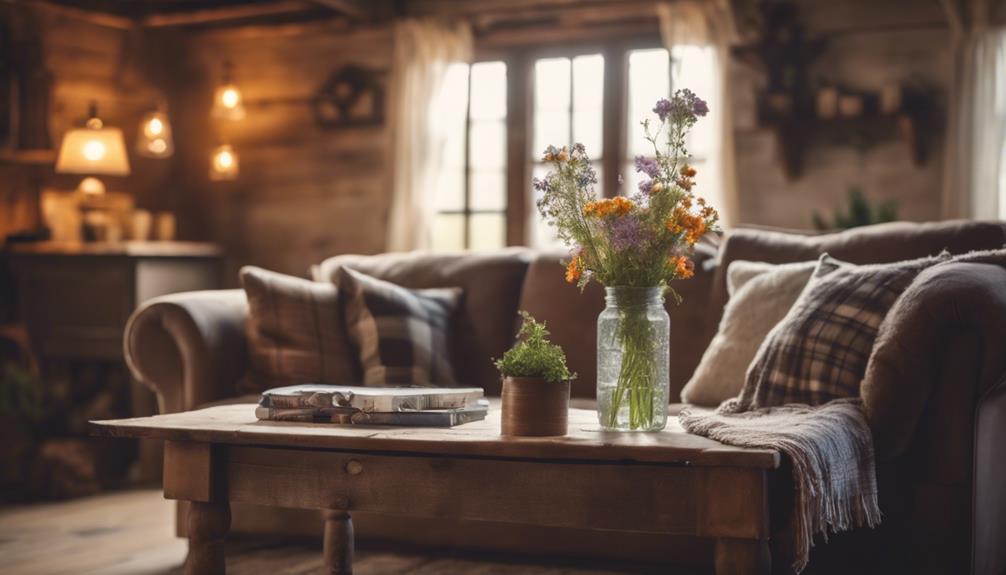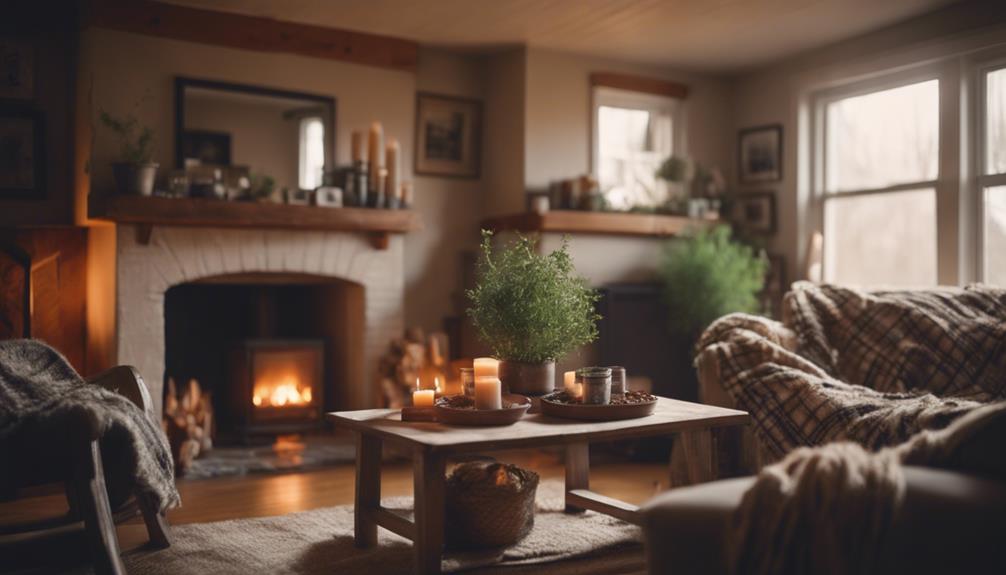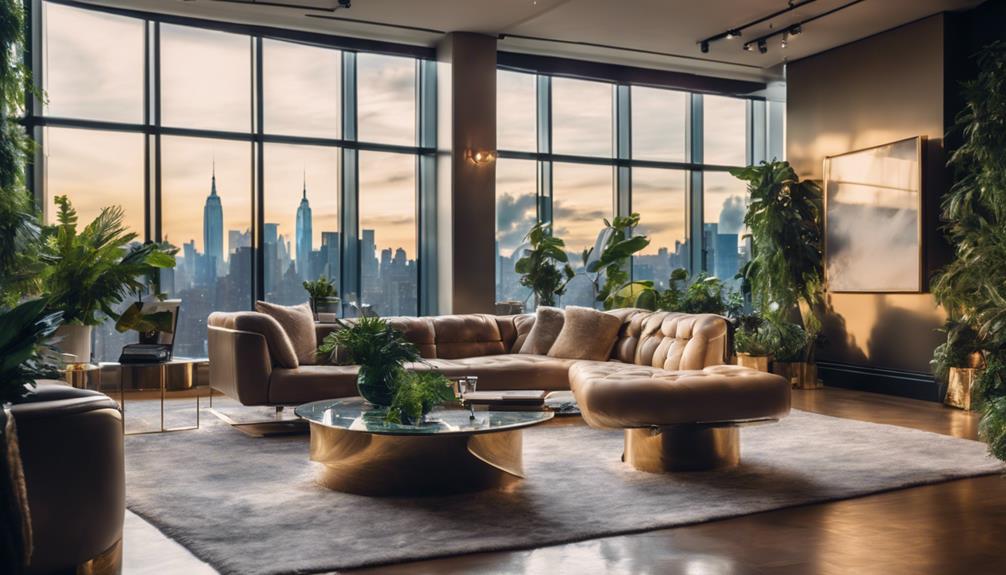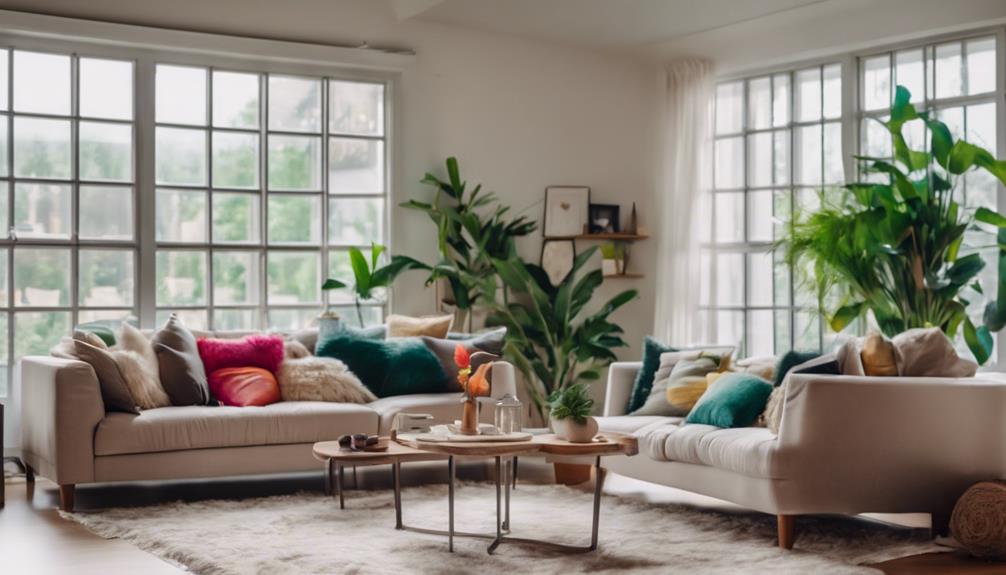Farmhouse decor can turn your house into a warm and welcoming retreat with its rustic charm. To achieve this cozy feel, consider using natural elements such as distressed wood and metal, and opt for a neutral color scheme to create a sense of warmth. Mix different textures like burlap and chunky knits with soft fabrics, and layer lighting for a cozy atmosphere. Add vintage pieces with a story to tell, and personalize your space with family heirlooms or gallery walls. Make sure to incorporate comfortable furniture throughout your home, such as oversized sofas and layered bedding. These tips will help elevate your home and make it even more inviting. Stay tuned for more ideas!
Key Takeaways
- Utilize natural materials like reclaimed wood and metal to enhance rustic charm and warmth in your decor.
- Opt for a neutral color palette, incorporating earthy tones and soft pastels to create a cohesive and inviting atmosphere.
- Layer soft fabrics, such as burlap and cotton, to add texture and comfort throughout your home.
- Incorporate vintage or antique furnishings to add character and a sense of history to your spaces.
Definition of Farmhouse Decor
What exactly is farmhouse decor? It's a style that combines rustic charm with modern aesthetics, focusing on creating comfortable and inviting spaces. You'll find that farmhouse decor ideas often emphasize the use of natural materials like wood and metal, giving your home a warm, lived-in feel. This approach makes your space feel more genuine and connected to nature, perfect for a cozy farmhouse vibe.
Neutral color palettes dominate this style, incorporating soothing shades of white, gray, and brown. These colors not only create a calming atmosphere but also allow your decor to shine without overwhelming the senses. Vintage or antique furniture pieces are commonly featured, adding character and a sense of history to your home.
Farmhouse decor has gained popularity over the years, especially through social media, where you'll discover countless inspiring designs and ideas. By embracing this style, you'll create an inviting environment that reflects both comfort and simplicity, making your home a perfect retreat.
Essential Materials and Colors

When choosing materials for your farmhouse decor, focus on natural options like distressed wood that bring rustic charm to your space.
A neutral color palette creates a calming atmosphere, allowing you to layer textures for added warmth.
Incorporating earthy tones and subtle patterns will enhance the inviting feel while keeping everything cohesive.
Natural Material Selection
Natural materials like reclaimed wood, metal, and linen are essential in creating the warm and inviting atmosphere characteristic of farmhouse decor. When you choose reclaimed wood for furniture and accents, you add a unique character and a sense of history to your space. This type of wood isn't only sustainable but also imbues your home with rustic charm that tells a story.
Textures are vital in achieving that cozy farmhouse feel. Consider layering burlap, linen, and cotton throughout your decor. These natural materials not only enhance the tactile experience but also create visual interest. By incorporating various textures, you can make your space feel more dynamic and comfortable.
While we'll discuss colors later, remember that the natural materials you select should complement a neutral color palette. Shades of white, cream, and soft pastels work harmoniously with these elements, enhancing their beauty.
When you embrace these natural materials, you're not just decorating; you're creating an inviting sanctuary that reflects your personal style while celebrating the beauty of simplicity. So, focus on reclaimed wood and rich textures to build a farmhouse aesthetic that feels truly welcoming.
Neutral Color Palette
Choosing a neutral color palette is key to enhancing the warmth and charm of your farmhouse decor, allowing the natural materials you've selected to shine beautifully. A neutral palette typically includes shades of white, cream, beige, and soft pastels, creating a cozy and serene environment that serves as a versatile backdrop for your farmhouse design. By incorporating earthy tones like warm grays and taupes, you can further enhance the inviting atmosphere characteristic of this style.
Don't shy away from adding darker colors, such as navy or forest green, as accent shades. They can create a dramatic effect without overwhelming your overall design, ensuring a balanced and harmonious look. Utilizing natural materials, like wood and stone, in these neutral tones contributes to the warmth and authenticity of your interiors, fostering a connection with the surrounding environment.
To maintain a cohesive aesthetic throughout your home, stick with a unified neutral palette. This approach helps enhance the sense of space and comfort, making each area feel interconnected and warm and inviting.
With these elements in place, your farmhouse decor will exude a timeless charm that feels both stylish and welcoming.
Textures for Warmth
Incorporating a variety of textures, like soft linens and rugged woods, consistently elevates the warmth and comfort of your farmhouse decor.
Start with natural wood elements, such as a reclaimed wood dining table or wooden beams, to create a strong foundation. These pieces not only add character but also evoke a sense of coziness.
Next, layer in soft fabrics to enhance that inviting atmosphere. Think about using burlap, cotton, or chunky knits for throw pillows and blankets. These textures provide tactile appeal, making your space feel lived-in and warm.
Don't forget about layered rugs; they can add depth and warmth underfoot while showcasing different textures.
With a neutral color palette as your backdrop, you can effortlessly mix these textures. Shades of white, cream, and beige allow the various materials to shine without overwhelming the space.
Earthy tones can also be incorporated to harmonize your decor, tying together the natural wood and soft textiles.
Key Elements of Cozy Spaces

Creating a cozy space involves layering soft textiles, utilizing warm lighting, and adding personal touches that invite comfort and relaxation. To achieve this, you'll want to incorporate elements that evoke warmth and a sense of home.
Here's a quick reference to help you visualize the key components:
| Element | Description | Emotional Impact |
|---|---|---|
| Soft Textiles | Throws and pillows add warmth and comfort. | Invites you to snuggle in and relax. |
| Layered Lighting | Combine ambient, task, and accent lighting. | Creates a welcoming glow for any occasion. |
| Natural Materials | Use wood and stone for a connection to nature. | Fosters a sense of peace and tranquility. |
| Personal Touches | Display family photos and meaningful decor. | Enhances your sense of belonging and identity. |
These key elements work together to create cozy spaces that encourage relaxation. Designating specific areas, like a reading nook or an intimate seating arrangement, can further enhance the coziness of your home. By thoughtfully combining these features, you'll create an inviting atmosphere that feels just right.
Room-Specific Farmhouse Designs

When you think about room-specific farmhouse designs, each space has unique essentials that enhance its charm and functionality.
In the living room, oversized sofas and reclaimed wood pieces invite comfort for gatherings.
Meanwhile, the kitchen's open shelving and farmhouse sinks create a warm atmosphere for family meals.
Living Room Essentials
A cozy farmhouse living room centers around oversized sofas that invite relaxation and comfort, complemented by soft pillows and warm throws.
To enhance this inviting atmosphere, consider adding a reclaimed wood coffee table as a functional centerpiece. Its rustic charm will ground the space, making it perfect for gathering with friends or family.
For those finishing touches, incorporate vintage decor pieces like antique picture frames or rustic wall art to add character and a sense of history.
Layered lighting is essential, so mix pendant lights with table lamps to create a warm glow that welcomes everyone.
Don't forget to bring nature indoors; adding potted plants or fresh flowers not only enhances the cozy feel but also brightens the room with natural beauty.
This combination of elements will guarantee your living room embodies the essence of farmhouse decor, providing a space where comfort meets style.
Embrace these essentials to create a living room that feels both homey and charming, capturing the heart of farmhouse living.
With these simple touches, your living room will become a cozy retreat for everyone who enters.
Kitchen Functionalities
Farmhouse kitchens blend functionality with rustic charm, making them perfect for both cooking and gathering.
One of the standout features is open shelving, which allows you to display dishware and decorative items, enhancing organization and adding visual interest. You'll find that a farmhouse sink, with its deep basin, not only looks great but also makes washing large pots and pans a breeze.
Butcher block countertops are another popular choice that brings warmth and a natural touch, providing an ideal surface for food preparation. These countertops aren't just attractive; they're highly functional and durable, perfect for your busy kitchen.
To complement the overall farmhouse aesthetic, vintage-style appliances in muted colors can enhance the charm while ensuring your kitchen remains efficient. These appliances not only serve a purpose but also add character to your space.
Bedroom Comfort Features
Comfort takes center stage in bedroom designs that embrace a rustic farmhouse aesthetic, inviting you to unwind and relax in a cozy retreat.
Layered textiles are essential; think cozy quilts, soft throws, and a mix of pillows that create an inviting atmosphere perfect for lounging after a long day. Incorporating rustic accents like reclaimed wood bed frames and vintage nightstands adds character and warmth, making the space feel uniquely yours.
Natural light is a game changer in farmhouse bedrooms. Large windows paired with sheer curtains allow sunlight to filter through, enhancing the cozy vibe and brightening your mornings.
When choosing colors, opt for earthy palettes with soft neutrals and muted tones. These choices not only promote tranquility but also create a serene environment conducive to restful sleep.
Outdoor Spaces and Maintenance

How can you transform your outdoor spaces into inviting retreats that reflect the farmhouse aesthetic while ensuring they remain well-maintained?
Start by incorporating comfortable seating made from rustic materials like reclaimed wood. This not only enhances the farmhouse vibe but also creates cozy gathering areas for family and friends.
Consider adding functional elements such as gardens or herb patches; they beautify the space and provide fresh ingredients for your meals. To create a cozy ambiance during evening gatherings, install outdoor lighting like string lights or lanterns, extending the usability of your outdoor areas.
However, maintaining these spaces is vital. Regularly check wooden structures for rot and use natural cleaning products to preserve their integrity.
Scheduling seasonal inspections for roofs and foundations is essential to prevent moisture buildup and mold, ensuring your outdoor spaces remain safe and welcoming.
Tips for Personalizing Your Home

Personalizing your home starts with incorporating meaningful decor items that reflect your unique story and experiences. By choosing pieces that hold sentimental value, you create a cozy atmosphere that fosters a personal connection.
Consider these tips to enhance your home decor:
- Incorporate family heirlooms or travel souvenirs to showcase your history and adventures.
- Create a gallery wall with family photos or artwork that resonates with your design style, making your space feel inviting and intimate.
Mixing textures, such as chunky knit throws with linen pillows, can enhance the comfort of your space while reflecting your personal style.
Additionally, rotating seasonal decor—like wreaths or table centerpieces—helps keep your home fresh and aligned with your evolving tastes throughout the year.
Frequently Asked Questions
How Do I Make My House Cozy and Inviting?
To make your house cozy and inviting, incorporate soft textiles, warm lighting, and natural materials. Personalize your space with meaningful decor and create comfortable areas that encourage relaxation and gatherings with family and friends.
How Do You Make a Farmhouse Cozy?
To make a farmhouse cozy, focus on fabric and furnishings. Fluffy throws and friendly furniture foster warmth. Utilize soft lighting and personal touches to create a welcoming, wonderful atmosphere that feels like home.
What Is Cozy Farmhouse Style?
Cozy farmhouse style blends rustic charm with modern simplicity. You'll love the neutral color palette, natural materials, and vintage furniture that create warmth. Personal touches like family photos enhance the inviting atmosphere, making it uniquely yours.
What Style Is Replacing a Modern Farmhouse?
The modern farmhouse is slowly being overshadowed by the enchanting allure of modern cottage style, with its dreamy vintage elements and soft colors, while Scandinavian farmhouse, bohemian, and urban farmhouse styles also rise in popularity.
How Can Farmhouse Decor Create a Productive and Inviting Home Office Environment?
Transforming your home office into a country-inspired space can significantly boost your productivity. With farmhouse decor elements like rustic furniture, warm color palettes, and natural textures, you can create an inviting and inspiring work environment that enhances focus and efficiency. Embracing this style can breathe new life into your countryinspired home office productivity.
Conclusion
As you embrace farmhouse decor, you're not just transforming your space—you're crafting a haven that whispers warmth and comfort.
Imagine stepping inside, greeted by soft textures and earthy hues.
But wait, what if you could infuse your personal touch, making each corner uniquely yours?
The journey doesn't end here; it's just beginning.
With every choice, you're one step closer to a cozy retreat that feels like home.
What'll you add next to bring it all together?









